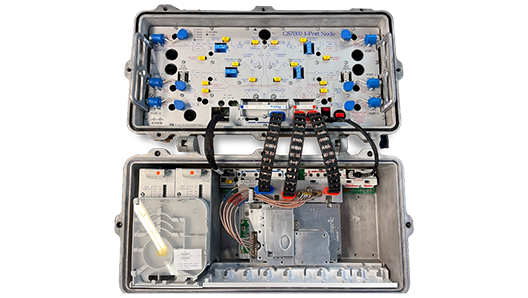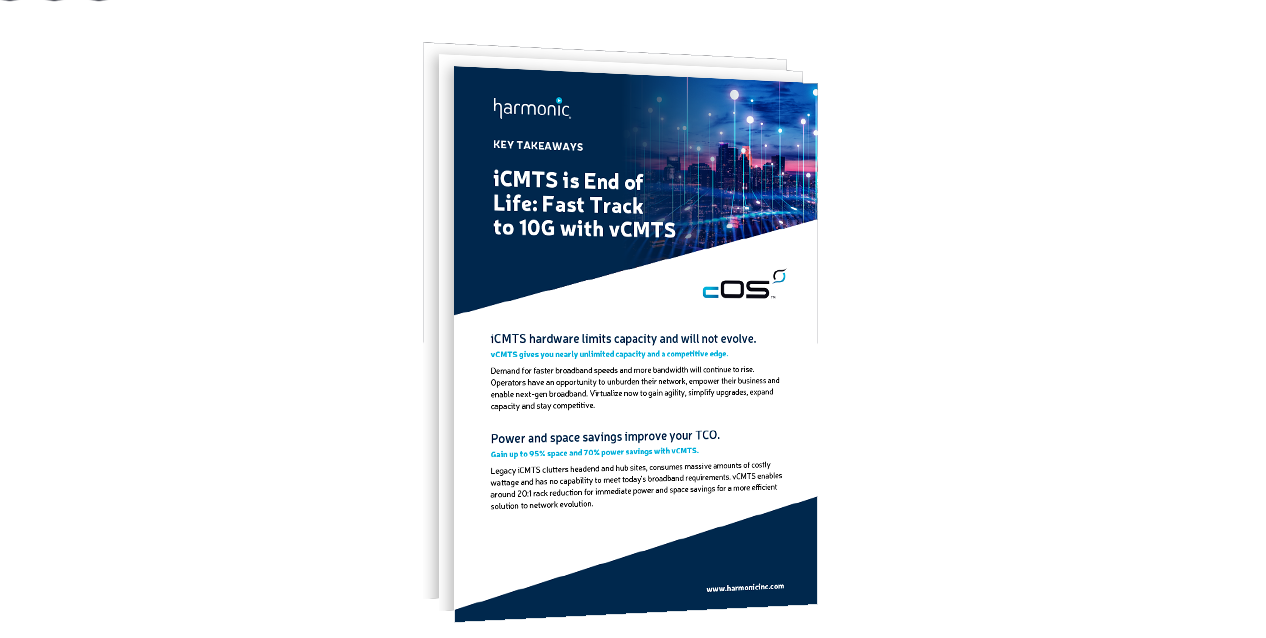Leveraging Existing Infrastructure to Provide New
High-Speed Broadband Services
Leveraging Existing Infrastructure to Extend
High-Speed Broadband Services
As broadband operators face growing competitive pressures, the race is on to quickly deploy fiber and enable efficient delivery of new, differentiated service offerings. Harmonic's cOS broadband platform offers multiple strategies to accelerate time to market, drive subscriber retention and win in this highly competitive environment.
In a discussion with Omdia analyst Jaime Lenderman, Harmonic Vice President of Access Networks Solutions and Strategy Rich Rommes explores these strategies and shares insights into how operators can leverage existing infrastructure to extend high-speed broadband services into both brownfield and greenfield areas.
Online courses at your
own pace
Lorem ipsum dolor sit amet, consectetur adipisicing elit, sed do eiusmod tempor incididunt ut labore et dolore magna aliqua. Ut enim ad minim veniam, quis nostrud exercitation ullamco laboris nisi ut aliquip ex ea commodo consequat.
Overcoming competitive pressures
Today we are here to talk about all things broadband, what's happening in the industry.
What are some of the major drivers for fiber deployments we're seeing right now?
I think in almost all cases, when people are asked what those factors are, operators respond with, "It's competition, competitive pressures, or increasing service levels," which is really just a driver from competition anyway. So being able to maintain customers, not lose customers, get new customers, it's all based upon the services that they can provide, how fast they can provide it.
What are some of the things that Harmonic is doing to support operators to overcome some of these challenges?
Harmonic's focus is on allowing operators to utilize their existing infrastructure. Oftentimes, operators look at how best to compete or how best to roll out to the next technology, and they think that that requires a complete overbuild or fiber everywhere. But most operators today have some degree of fiber already deployed; the middle mile, the backbone, fiber's already deployed. And if they have some active equipment on the edge, then they can just enable that edge equipment with the fiber to be able to deploy more high-speed fiber-based services more quickly. We provide that functionality to customers by providing a breadth of different products. So whether it's a headend-based product with PON or a cabinet-based product with PON and switches, or if it's even an outdoor enclosure type of service that we can provide, that allows cable operators – any operator – to use their fiber services, deploy a device very quickly and get out in front of their competitors, sometimes even convince them not to build in their neighborhoods.
Online courses at your
own pace
Lorem ipsum dolor sit amet, consectetur adipisicing elit, sed do eiusmod tempor incididunt ut labore et dolore magna aliqua. Ut enim ad minim veniam, quis nostrud exercitation ullamco laboris nisi ut aliquip ex ea commodo consequat.
Online courses at your
own pace
Lorem ipsum dolor sit amet, consectetur adipisicing elit, sed do eiusmod tempor incididunt ut labore et dolore magna aliqua. Ut enim ad minim veniam, quis nostrud exercitation ullamco laboris nisi ut aliquip ex ea commodo consequat.
Online courses at your
own pace
Lorem ipsum dolor sit amet, consectetur adipisicing elit, sed do eiusmod tempor incididunt ut labore et dolore magna aliqua. Ut enim ad minim veniam, quis nostrud exercitation ullamco laboris nisi ut aliquip ex ea commodo consequat.
Online courses at your
own pace
Lorem ipsum dolor sit amet, consectetur adipisicing elit, sed do eiusmod tempor incididunt ut labore et dolore magna aliqua. Ut enim ad minim veniam, quis nostrud exercitation ullamco laboris nisi ut aliquip ex ea commodo consequat.
Addressing distance and density challenges
In regards to distance and/or density, how are some of the Harmonic solutions helping operators with their deployment models?
Harmonic offers a wide variety of solutions, and those solutions offer, or rather can support, different optical interfaces. For instance, one of our devices, the Wharf, supports a QSFP-DD interface that allows us to support coherent optics. So 400-gig, 100-gig, out to a very long distance, hundreds of kilometers. So instead of building everything in a headend, or even having to build a bunch of smaller hubs out in the field, you can simply put a small enclosure in the field and have very high-speed connectivity to that enclosure, and then feed off of that. So I can go hundreds, even thousands of kilometers, potentially, with our equipment, based upon the type of deployment model or densities that you are looking at for that particular deployment.
Reaping the benefits of interoperability
With regards to something like interoperability, what are we seeing and what is the significance of that in the industry today?
I think it's huge. When you look at the earlier days of PON, interoperability wasn't that important because each vendor had their own equipment, and you never really were concerned about interoperability outside of that vendor's environment. Today, you have a host of vendors out there that make ONUs/ONTs, and those units need to interoperate. In most vendor environments, there is a desire to only work with their own equipment. The strategy with Harmonic is to work with any vendor's ONU/ONT product, and that's not as easy as said. XGS is working towards a model that helps get there. DPoE allowed operators to get there earlier, the interoperability was not an issue. With XGS it is an issue. And if you're potentially relying on one vendor's ONU, and then you have a supply issue come up and now those ONUs aren't available anymore, you need to be able to go to a different provider, a different vendor, to fill that void. And that's one of the beauties of Harmonic's solution is that we support any ONU vendor. Unfortunately, it's going to take some time for the standards bodies to get to the point where everyone works in a harmonious environment, no pun intended, and allow vendors, allow operators, rather, to just pick and choose for different equipment vendors.
Enabling the next generation of PON
There's many different avenues, many different places where operators are right now. What would you say is some general advice for future-proofing
the next generation of PON?
I think as you look at operators' networks, as I mentioned, there's a lot of fiber in the backbone, there's not a lot of fiber in the last mile. Last mile is where you really need to be prepared to provide those higher level services. And an interesting thing about that is that you don't have to build a hundred percent of that last-mile network, you only need to build where the capital really shows that there's a true need to do so. We call that getting rid of regrettable spend. Only allocate your capital where it's absolutely needed. If you have an active device out in the field, and you have a housing development popping up, it's easy to just extend the ethernet connectivity from that active device in the field and do PON from that point out to your customers. Your time to deployment is so much faster, your costs are so much less. We have one customer of ours that says that he chose our solution because he can deploy PON in areas faster than some of their competitors' cement will dry on the actual cabinets they're building. So it's time to market, but it's also having the infrastructure fiber back-office systems that allow you to take advantage of new technologies as they come up.
Taking advantage of new business opportunities
How should operators prepare for future opportunities, as well as challenges?
I think the most important thing is being flexible and having options. You know, there's new standards coming out, for instance, and a lot of times we don't know how those new standards are gonna roll out. Will they be adopted en masse, or will they be adopted only by certain customers? Will your deployment and MDUs require something different than with your customers that are in single family homes? Chances are they will. So having the flexibility to do multiple media types, multiple architecture types, is is very important. Also, the need to deploy quickly. So time to market is of the essence for all of the operators out there today.
An interesting point with the BEAD funding and the RDA funding is that the government is incentivizing new fiber builds to provide services to underserved areas. The problem with that is if you're an operator just outside of an area that is underserved and you didn't win that bid, the person that did win that bid has to build fiber in that area. They have to bring that fiber into that area somehow, and it's not going to go around your area, it's going to go through your area. And they're going to run that fiber where they can cherry-pick the best group of customers they possibly can. Now, all of a sudden, you had no competition, now you have the competition where they're taking some of your best customers in some of the densest areas while they go and try to support the least-dense areas. To be able to jump quickly to a last-mile deployment methodology that allows you to upgrade your services quickly is really key. And that's what Harmonic allows for our customers. We give customers access to outdoor enclosure-based designs, cabinet-based designs, datacenter-type designs where it's centralized. You have the freedom to do all of those.
One of our customers has said that he chose Harmonic because as he's being overbuilt in areas, he can often deploy one of our outdoor enclosures, either on a pole or on a pad, faster than it takes the new competitor to get the permits and have the concrete dry on the cabinet. So, again, it's time to market. He needs to fend off the new fiber providers that are not necessarily overbuilding him entirely, but just in that one area. And I don't know if I mentioned this, but those operators, they can't get money for their existing areas. They already serve their customers in a manner in which the FCC is okay with, so they don't have the luxury of going out and getting money to upgrade themselves to compete against the new player. So being able to provide new services, advanced services, in a very quick manner, with very little capital, and using as much infrastructure as possible, that's what customers need to do, and that's what Harmonic provides.
Learn more about cOS fiber deployment strategies
Find out how Harmonic can enhance your DOCSIS network and accelerate your move to 10G fiber.
Panel session
Thomas will speak about varied approaches to streaming content resiliently at scale, and the challenges of delivering live events to large audiences.

Let's talk about fiber
Thank you for your interest in Harmonic's FTTx solutions.











